Our view at Stack - Pipedrive is a robust CRM platform, offering automation, contact data collection, webhooks, AI-powered sales assistant, email communications, email marketing, and customisable sales pipeline workflows.
As employees increasingly prioritize work-life balance, more companies are embracing flexible work schedules. Giving employees the autonomy to decide when or where to work often leads to higher satisfaction and productivity.
However, there’s no one way to implement flex hours. You can adopt various schedules to keep employees and employers happy with the work arrangements.
In this guide, we’ll break down the different types of flexible work schedules so you can choose one that works for your business. We’ll also share some tools to help small business owners enable flex work in their companies.
What is a flexible work schedule?
A flexible work schedule is an alternative set of hours or workdays to the traditional 9–5, Monday to Friday. It typically lets employees vary their working hours or location to fit their personal needs and preferences.
The idea is to give staff and prospective employees more control over when, where and how they work while still meeting business needs.
Companies can offer various types of flexible work schedules, from compressed work schedules to part-time schedules to remote or hybrid options. We’ll dive into each of these in a moment.
Common misconceptions about flexible work
People often have the wrong idea about what flexible work really means. Before we discuss the types of flexible work arrangements, it’s important to clarify what flexible working is not.
Let’s debunk some myths:
-
Flexible work means remote work. Flexible work is an umbrella term that also includes things like adjustable hours, shorter workweeks and job sharing.
-
Flexible work means your people are less productive. Productivity often increases when you trust employees to manage their time and work in ways that suit them. We’ll talk more about this later.
-
Flexible work is difficult to manage. The tools and tried-and-tested policies available today make managing remote teams easier than ever. You can still keep processes organized and get great results.
Now that we’ve cleared up these misconceptions, let’s explore what flexible work really looks like.
8 types of flexible work schedules
You can implement different types of flexible work schedules in your company. Knowing how these schedules work is important when finding the best fit for your industry, employees and business model.
Here are eight types of flexible work schedules to know.
1. Remote work
Remote work (sometimes called telework or telecommuting) is when employees can work from any location outside the office, such as home, a coworking space or a coffee shop.
Some remote companies also let their employees choose their hours (e.g., working after “office hours”) as long as they complete tasks on time.
Remote work has become more common since the pandemic. Companies like Quora and Basecamp are still remote-first even today.
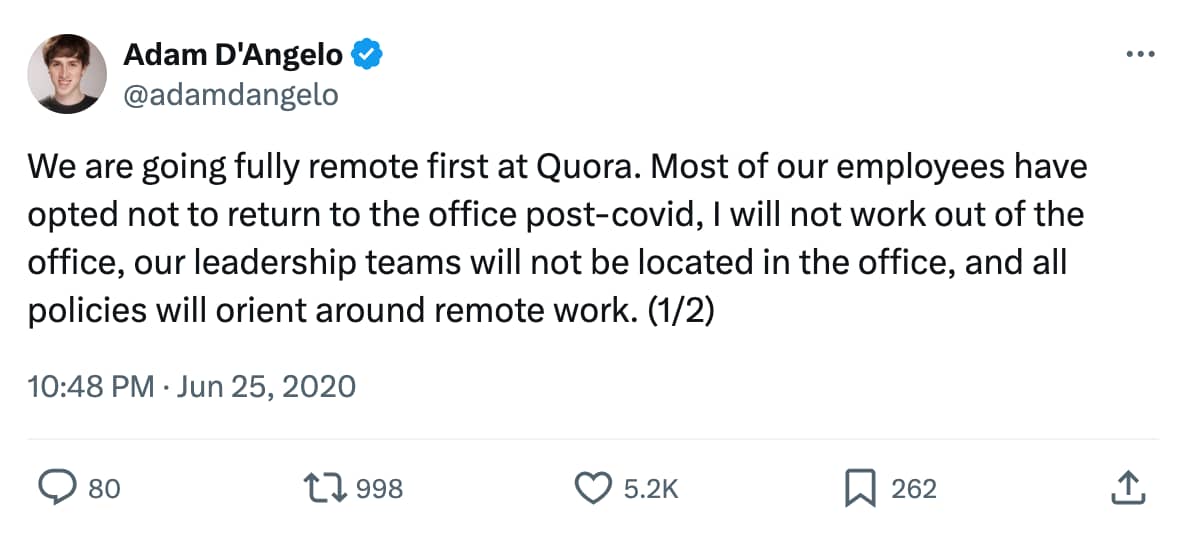
The pros and cons of remote work schedules
Working remotely offers tons of benefits for everyone. Companies save money on office space and can hire from a wider, even global talent pool. Employees get to avoid commutes, choose where they live and work in a more comfortable environment.
Many remote workers also report feeling more in control of their work-life balance, which can significantly reduce stress and anxiety.
For businesses, having happier and more productive employees means less turnover.
Oyster CEO Tony Jamous shared the remote work benefits Oyster has experienced on LinkedIn:
Remote work also has its challenges. For example, lacking social interaction and proper boundaries can lead to burnout and isolation.
To combat these issues, companies can regularly schedule video calls and organize virtual team-building activities and in-person meetups or retreats.
Setting clear work hours and communication expectations can also help your team balance their personal and professional lives.
2. Hybrid work
Hybrid work combines remote work with in-office days so employees can split their time between work environments. For example, employees might come into the office twice a week and work from home the rest of the time.
Top companies like Adobe and Microsoft have embraced hybrid work, allowing their employees to enjoy the perks of working from home while still upholding company culture.
The pros and cons of hybrid work schedules
Hybrid schedules are a good fit for employees who crave flexibility but still enjoy social interaction.
A study by Gallup showed over half of US employees (with remote-capable jobs) prefer hybrid work over on-site or fully remote settings.
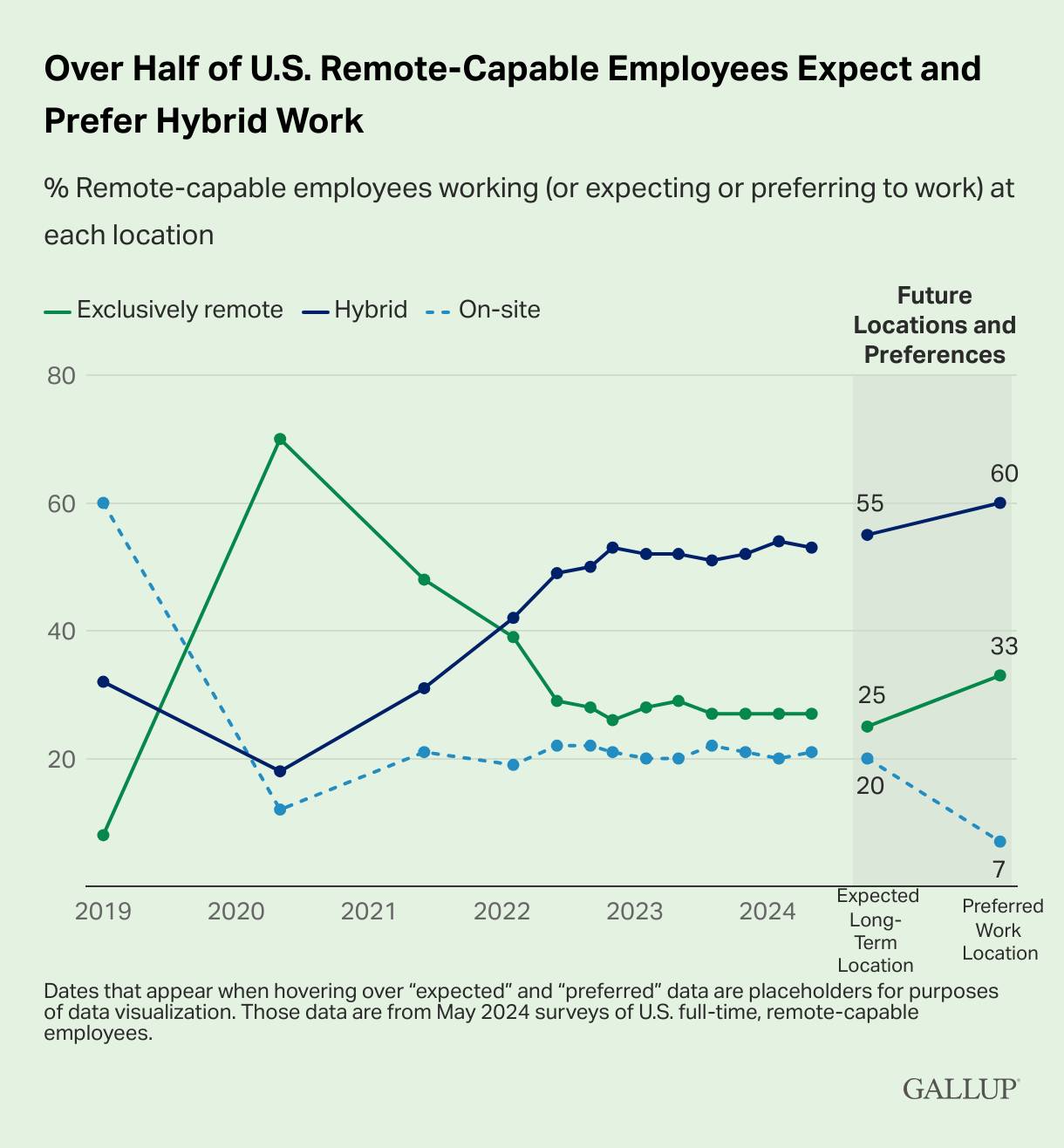
Flexify founder Matthew Stott explained that hybrid work is about finding the balance:
Hybrid work has its benefits, but it hasn’t worked for everyone.
Some previously hybrid companies (like Amazon) found it challenging to manage such a large number of people working on and off-site and have asked employees to return to the office five days a week.
However, a well-managed hybrid model can offer significant advantages for smaller teams, such as reduced overheads and a happier, more productive workforce.
To make things easier, you could set specific days for in-person meetings or collaborative projects, invest in good tech and focus on results rather than where or how employees work.
Note: Make sure you treat both remote and in-office employees equally. Under the Fair Labor Standards Act (FLSA), all nonexempt US employees are entitled to protections like minimum wage and overtime hours pay, regardless of where they work.
3. Flex time
Flex time (or flextime or flexitime) lets employees choose their working hours as long as they complete their tasks or meet a set number of hours per week. The setup allows employees to work when they’re most productive, which can vary from person to person.
For example, an employee who attends evening classes might prefer to start working at 7 AM and finish by 3 PM. Similarly, people with morning commitments like childcare might prefer starting later (e.g., around 10 AM).
Companies like Expensify and DuckDuckGo let employees set their own schedules.
The pros and cons of flex time schedules
Flextime is popular with working parents and students as it gives them more control over their schedules. Some even prefer it over remote or hybrid settings. For them, fitting work around their lives, not the other way around, means less stress and frustration, even if it requires working out of the office five days a week.
Dominic McGregor, founder of Basecamp Skills, explained it like this:
A common challenge with flex time is that it can be difficult to coordinate meetings or projects when team members work different hours.
To overcome this, you can set core hours when everyone needs to be available (e.g., 1 PM–3 AM) and allow flexibility outside of these hours so that employees can adapt their start and end times to their lives.
4. Compressed workweek (including four-day workweek)
A compressed workweek condenses the traditional five-day workweek into fewer days (typically four days). There are two ways a company can set this up:
-
Employees work longer hours each day. For example, they might work four 10-hour days instead of five 8-hour days to complete a total of 40 hours per week.
-
Employees complete a shorter workweek. Some companies simply reduce the total number of weekly hours to 32 instead of 40.
The four-day workweek has gained popularity in recent years.
A study by Autonomy, alongside academics from the University of Cambridge and Boston College, found that after a four-day workweek trial, 92% of the companies involved decided to continue the practice after the pilot ended.
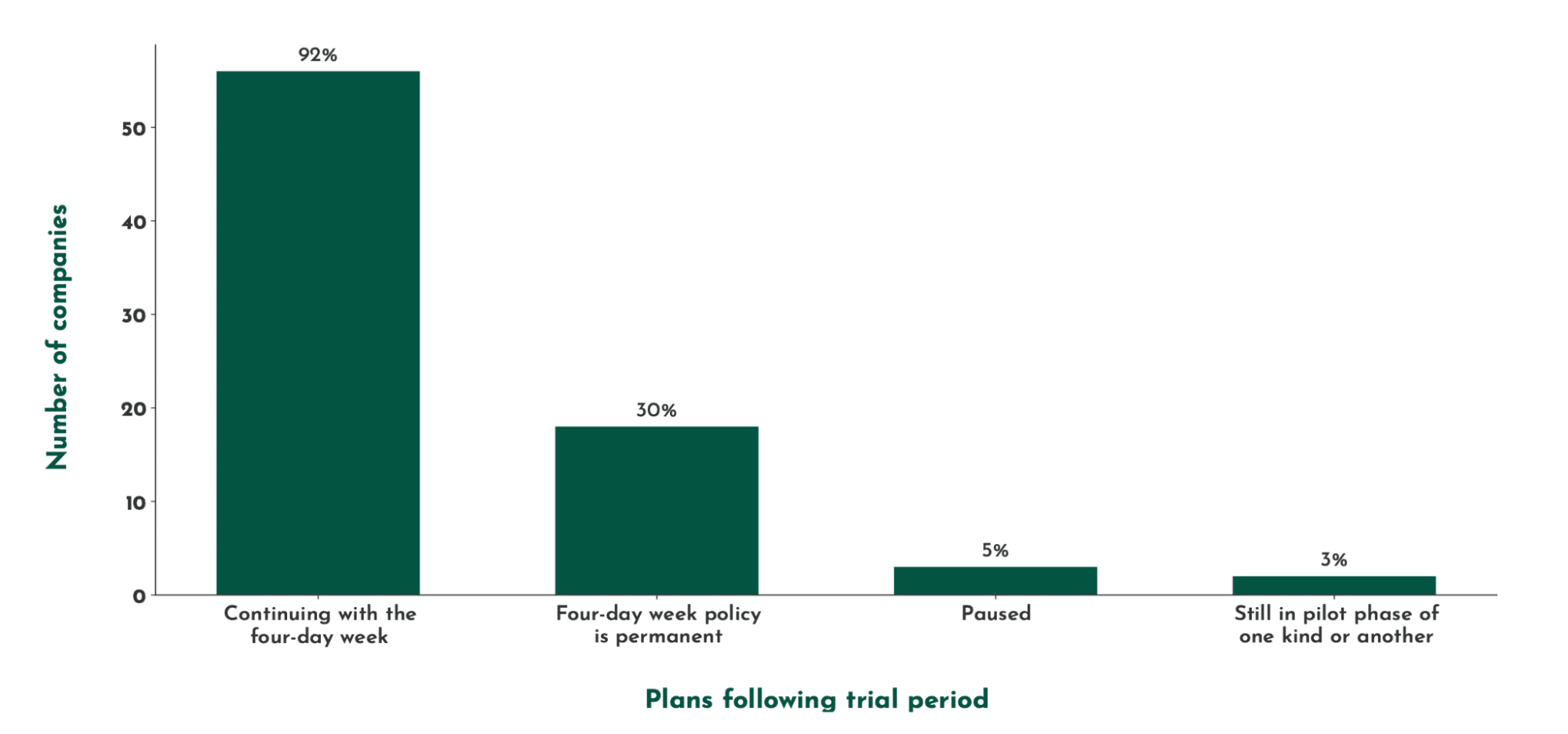
The study found that stress, burnout, anxiety, fatigue, sleep issues, and physical health issues decreased during the pilot.
It also found that, on average, companies’ revenues rose by an average of 1.4%, and the likelihood of an employee quitting decreased by 57%, showing the impact a flexible work schedule can have on employee experience and productivity.
The pros and cons of compressed workweeks
Compressed workweeks can benefit companies in more than one way. Microsoft Japan experimented with a four-day workweek with the following results:
-
40% increase in productivity
-
50% less time spent in meetings
-
25% fewer employee days off
-
23% reduction in electricity cost
-
Printing costs down by 48.7%
These results show that having more time out of the office during the week to rest can actually help employees be more productive while reducing company overheads at the same time.
It also has benefits for neurodivergent employees, as Gemma Ellison, Founder of Heart Leadership explained:
Compressed or four-day workweeks might not work for all industries. For example, customer service, retail, healthcare and hospitality businesses often require daily or round-the-clock operations.
Reducing work hours in these industries might create gaps, such as slower service or unmet customer or patient needs. If fewer employees are available to handle the workload, it can also increase pressure on existing staff.
However, there are a couple of ways 24/7 industries can still reap some of the benefits of compressed workweeks.
-
Implementing AI and automation tools. Using chatbots (customer service), self-checkout systems (retail) and appointment scheduling software (healthcare) can help companies continue to operate and offer basic services during off days.
-
Reducing hours at the individual level. In healthcare, for example, nurses can work compressed hours but alternate shifts with other staff to ensure round-the-clock patient care.
Providence Health System has also implemented an innovative model where nurses work some days on-site and others in a virtual setting to help with administrative tasks. Gregory Till, Chief People Officer at Providence Health System said of the new model:
5. Part-time work
Part-time work is when employees work fewer hours than a full-time (40 hours a week) schedule, often less than 32 hours a week.
Businesses often hire part-time workers for:
-
Seasonal positions (e.g., busy periods at a restaurant)
-
Specialized roles
-
Administrative tasks
-
Ad-hoc projects or fluctuating workload
-
Student or internship roles

Staples, for example, hires part-time workers for various on-site roles, especially in the warehouse category. They also offer some generous benefits to their part-time employees.
Note: Under US federal law, part-time workers are generally not entitled to the same benefits as full-time employees. However, if part-time employees work more than 1,000 hours in a year, they may be eligible for certain retirement benefits under the Employee Retirement Income Security Act (ERISA). Some states may also offer additional protections to part-time employees, such as paid sick leave (California) or predictable scheduling (Oregon).
The pros and cons of part-time work schedules
Part-time work schedules work well for employees who want to maintain a career while having more hours for family, studies, managing health issues or personal interests. Offering this flexibility also helps companies retain talent that might otherwise leave the workforce.
Smaller companies can also hire part-time employees to fill critical roles without committing to full-time salaries and employee benefits, which helps keep costs low.
As Molly Johnson-John, CEO & co-founder of Flexa, puts it, “Part-time doesn’t mean part-committed. It’s another form of flexible working that enables millions of people to remain in employment.”
Cassie Fidler, Product Manager at Lumery, elaborated on the benefits for people with health issues or childcare commitments:
Part-time work schedules can also present several challenges for employers. For instance, it can be difficult to schedule meetings or coordinate with part-time workers as they might have limited availability.
Additionally, part-time employees might not receive the same level of training or exposure to company processes and culture, which can lead to skill gaps, poor integration or communication issues within teams.
Here are some ways small businesses can deal with these potential issues:
-
Use tools like Google Drive, Slack and Loom to facilitate remote collaboration and asynchronous communication
-
Record and share all meetings so part-time employees can stay informed even if they don’t attend live sessions
-
Offer on-demand training using tools like Trainual or TalentLMS to help employees learn about policies and processes at their own pace
Consider a job-sharing arrangement in which two part-time employees split a job. We’ll discuss this further later.
Note: Under the Family and Medical Leave Act (FMLA), employees returning from maternity leave can legally request part-time work to care for a newborn child, subject to the employer’s approval. Some states like California, New Jersey and Rhode Island require employers to talk to the employee first and offer a legitimate business reason before rejecting a request.
6. Shift work
Shift work divides the workday into shifts so employees can work at different times, such as morning, evening or overnight.
This type of flexible work schedule is common in industries like food, healthcare, retail and manufacturing, which often operate for longer hours than traditional workplaces.
Factory workers often operate on rotating shifts to ensure the assembly line runs smoothly day and night. For example, an auto parts manufacturer might run three 8-hour shifts:
-
First shift: 7 AM to 3 PM
-
Second shift: 3 PM to 11 PM
-
Third shift: 11 PM to 7 AM
Full-time shift workers are typically eligible for standard benefits like health insurance, but part-time or temporary shift workers may not receive the same benefits. Some companies, however, offer prorated benefits to part-time shift workers based on their hours.
Note: Many shift workers, especially those in healthcare, retail and manufacturing, are non-exempt employees under the Fair Labor Standards Act (FLSA), so are entitled to overtime pay for hours worked beyond 40 hours a week.
The pros and cons of shift work schedules
Shift work is common in 24/7 industries as it enables companies to meet production targets, reduce downtime on expensive equipment and offer continuous service. Some employees might also work shifts at non-traditional hours to balance personal responsibilities.
Additionally, employees working night or irregular shifts may receive extra pay for less desirable hours (shift differentials), which could help increase their overall income.
Shift work offers flexibility, but it can impact mental and physical health, particularly for those working night shifts. Irregular sleep patterns can lead to fatigue, stress and even weight gain. Studies have also shown a link between poor sleep in shift workers and cardiovascular diseases.
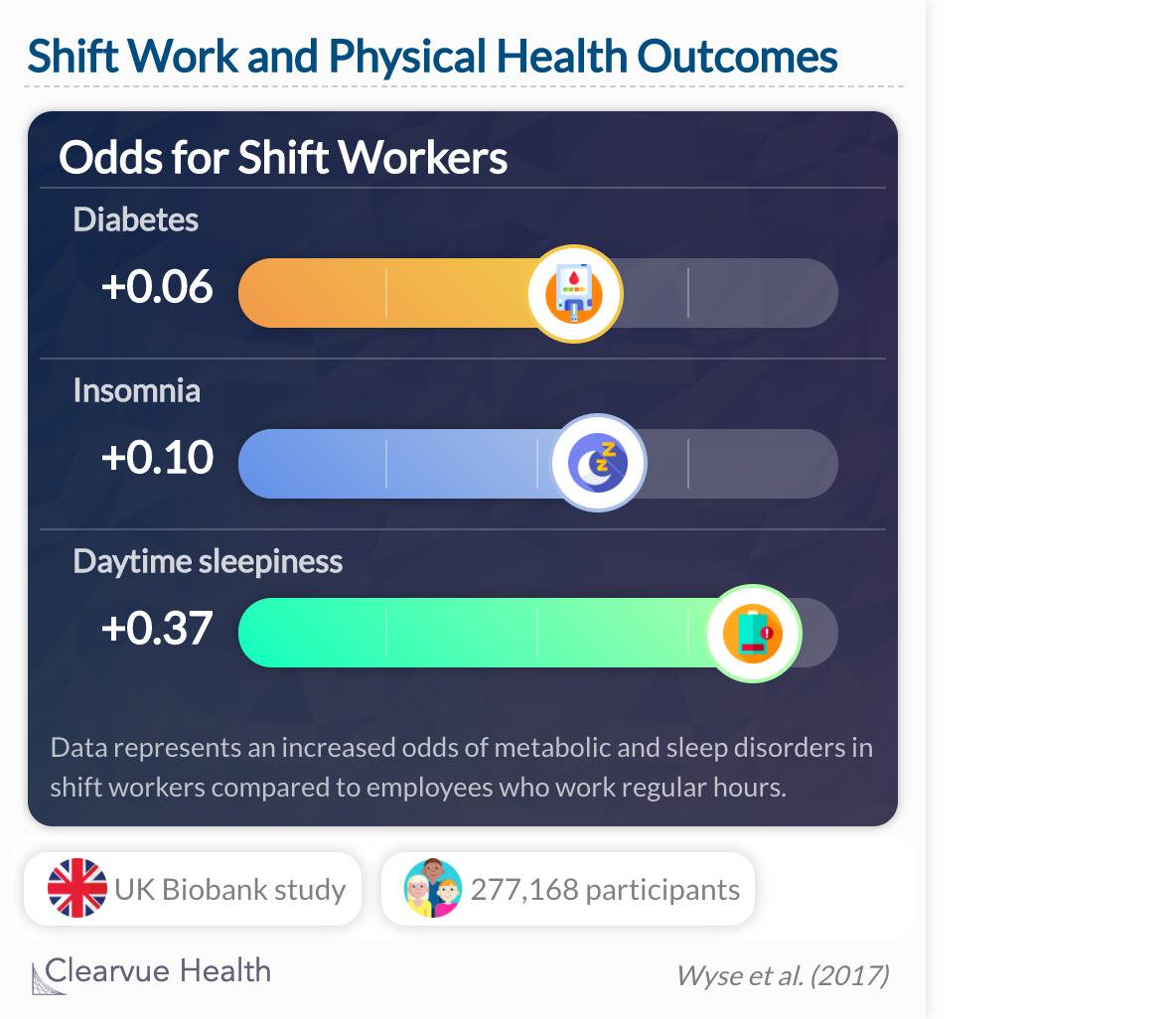
Here are some ways companies can mitigate risks associated with shift work:
-
Create shift schedules around employee availability and preferences
-
Provide regular health screenings to catch any issues early
-
Offer wellness support (e.g., meal plans or gym memberships.)
-
Educate employees on the importance of good sleep and diet
Sailynn Doyle, Business Coach and Founder of Passion Purpose Posture shared her experience on shift work:
7. Job-sharing or work-sharing
Job sharing (or work sharing) is when two or more employees split the responsibilities of a single full-time role. It gives employees the flexibility to work part-time while still contributing to a full-time position or completing projects on time.
Job sharing is often used in roles that require continuity but where full-time hours may not be necessary for each employee, such as administrative tasks, customer service, training or time-sensitive projects.
For example, job sharing is very common in primary teaching, where two teachers share the responsibility for one class. One teacher might work Monday to Wednesday, while the other covers Wednesday to Friday (with an overlap day on Wednesday to hand over lessons and student progress).
Employees who job share need to ensure they have an open line of communication so everyone understands what’s happened on the days they weren’t in the office.
The pros and cons of job-sharing schedules
Job-sharing offers several benefits, especially for employees seeking a better work-life balance. It lets them reduce their hours while still contributing to a full-time role, which can help alleviate stress and prevent burnout.
For employers, it ensures the role is always covered, even if one employee is unavailable. In teaching, for example, job-sharing often encourages young women to return to work after maternity leave by offering part-time flexibility without disrupting student learning.
Before you approve a job-sharing proposal, ensure the two employees are a good match in terms of working styles, punctuality and communication habits.
Susan Lovegren, Board Member and Advisor, said this about job sharing:
Companies should also set clear expectations and tasks for each employee in a job-sharing role so it’s easier to recognize individual contributions. They should also provide employees with the right tools to facilitate communication and collaboration.
8. Additional leave arrangements
Some non-traditional leave arrangements, like workations, can also help employees stay productive while taking extended time off.
Workations (or workcations) are when employees (temporarily) work remotely while traveling, usually from a vacation spot. Workations are getting increasingly popular as more employees gravitate towards the concept of “work-life integration” over “work-life balance”.
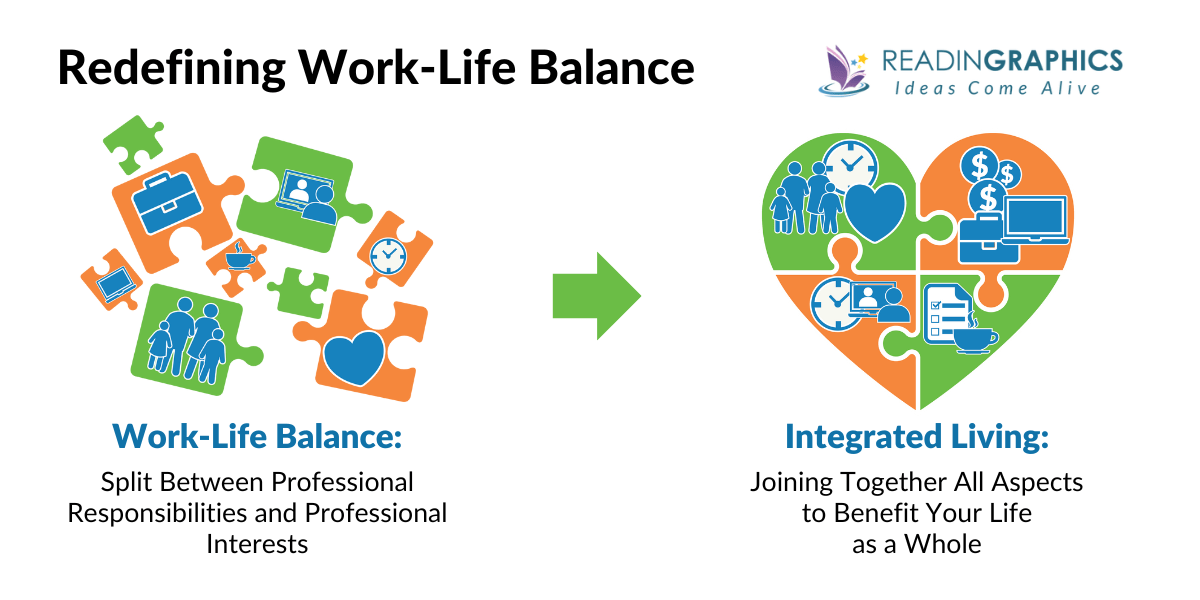
For example, an employee might take a workation by spending a month in Bali, working remotely during the day and enjoying the beaches and cultural activities in the evenings.
This arrangement can help blend work and relaxation in a way that supports both the employee’s personal and professional well-being.
Other flexible leave arrangements companies might want to consider include:
-
Sabbaticals offer employees extended periods of leave, typically after several years of service, to pursue personal projects, education or simply take a break from work. They’re designed to reduce burnout and help employees return with renewed energy and fresh perspectives.
-
Extended unpaid leave allows employees to take time off (without pay) for personal reasons like family care, travel or education. They don’t receive a salary during this time, but their job remains secure and they can return once the leave ends.
-
Volunteer leave provides employees with paid or unpaid time off to engage in charitable or community service work. It supports both the employee’s mental health and your company’s corporate social responsibility.
Companies like Siemens and Continental offer flexible arrangements like workations as part of their employee benefits. Many companies also offer paid or unpaid sabbaticals to employees who have stayed with the organization for a few years.
The pros and cons of flexible leave arrangements
Flexible leave arrangements (like workations) allow employees to travel and recharge while staying engaged with their work. Breaking free from routine and exploring new places can often boost creativity and fresh thinking. Employees may also feel more productive and motivated when they return to the office.
Some could argue that workations “ruin” the concept of vacationing or taking time off to relax and enjoy with family and friends. However, people have found ways to strike a healthy balance between the two, especially those choosing to live abroad temporarily.
Billy Cina, Managing Partner and Envy, described his approach like this:
Countries like Croatia, Spain and Malaysia even offer specialized digital nomad visas that allow visitors to stay up to a year or two while legally working.
To maximize efficiency in workations and other leave arrangements, SMBs can outline clear policies on who is eligible for these leaves, how much leave can be taken and the purpose of the leave. They can also set expectations around communication and core work hours so employees in different time zones can easily adapt.
Recommended reading

How to love your job in 2024: 13 simple tips
Benefits of flexible work schedules for small businesses
Flexible work schedules offer your business different ways to achieve better results and retain talent without committing thousands of dollars in overheads and full-time salaries.
Here are some specific benefits of alternative work schedules for small businesses, backed by real-life examples and recent data.
Increased employee satisfaction and retention
Flexible work schedules give employees more control over their time and have been proven to increase job satisfaction and employee engagement.
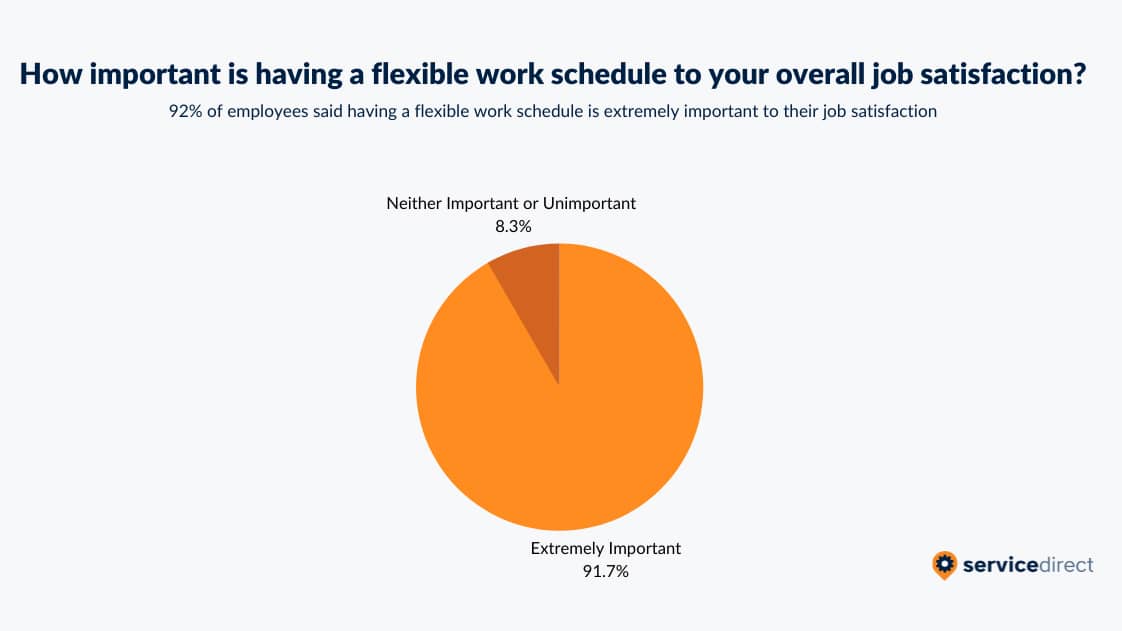
For small businesses, this also means employees are less likely to quit or switch to another company, reducing turnover costs. In fact, 88% of business leaders agree that flexible work options positively impact employee retention.
Recommended reading

Selling from home: How to do it and the tools you need to stay productive
Enhanced productivity and work-life balance
Flexible schedules let your employees work when they feel most productive.
Working from home (or any other comfortable environment) can also eliminate distractions and improve focus, leading to a 5% increase in employee productivity.
More importantly, working flexible hours helps employees balance their professional lives with their personal lives. According to Buffer, 78% of remote workers say they have healthy work-life boundaries.
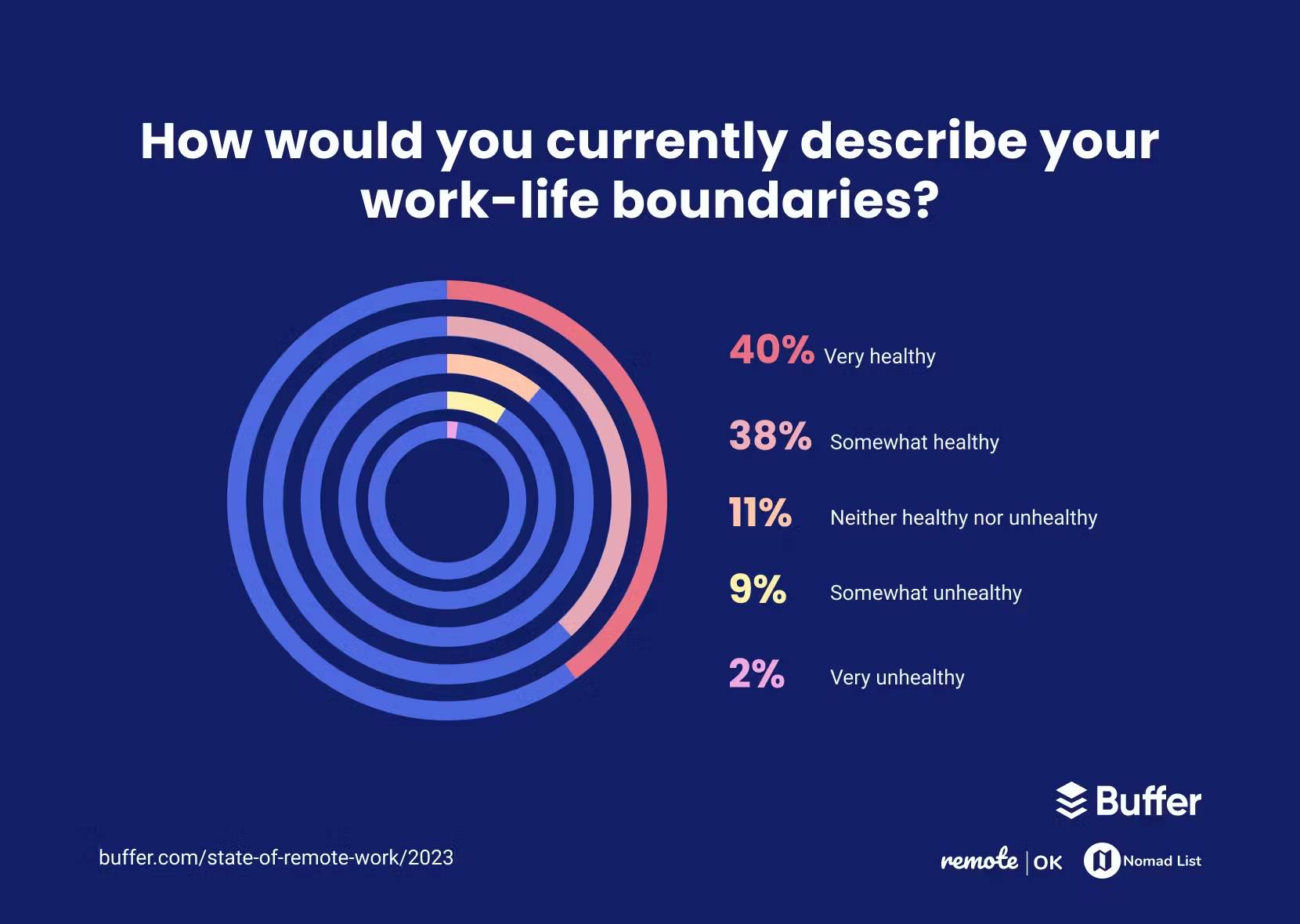
Small businesses often rely more on every team member’s contribution. Employees with a good work-life balance are less likely to experience burnout and stress. For your company, this means fewer sick days and better overall performance – a win-win!
Reduced overhead costs
One of the biggest benefits of flexible work schedules for small businesses is they can significantly bring down your expenses.
Research from Lemon.io shows startups can save up to $10,600 per remote employee by cutting back on office space, utilities and supplies.
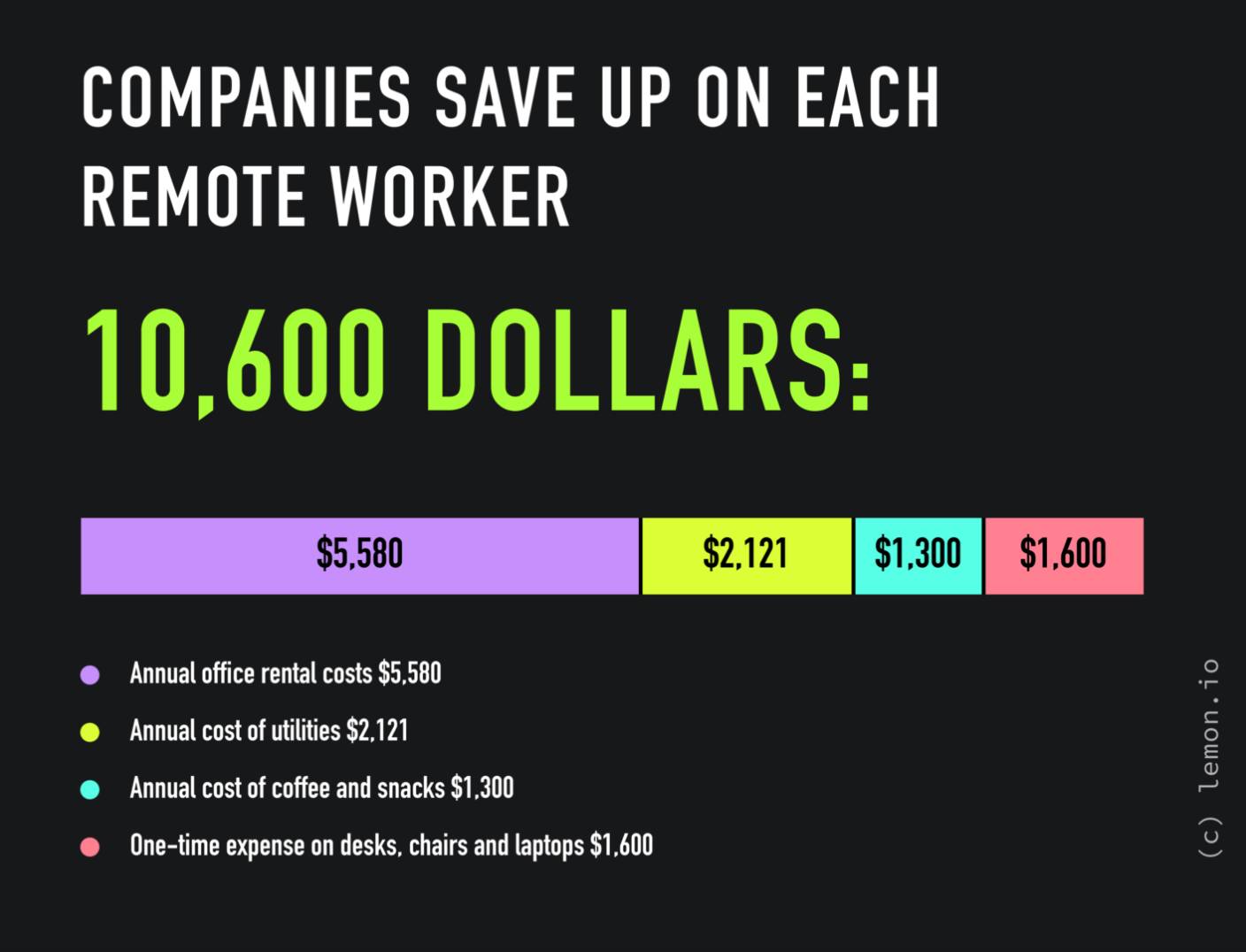
However, that’s not the only way companies can reduce their overheads. Another survey from FlexJobs revealed 50% of employees are even willing to take a pay cut to be able to work from anywhere.
Better talent attraction
Offering remote work lets your small business hire employees from all over the world, which widens your talent pool and helps you find the right fit within your budget.
Moreover, flexibility in work is no longer a “nice-to-have” for some employees, it’s a must-have. Offering flex schedules can help your small business attract top talent, even if you’re unable to match the salaries and perks of larger corporations.
According to Randstad Workmonitor 2024, candidates will decline a job if it doesn’t provide flexible working hours (41%) or flexible work location (37%).
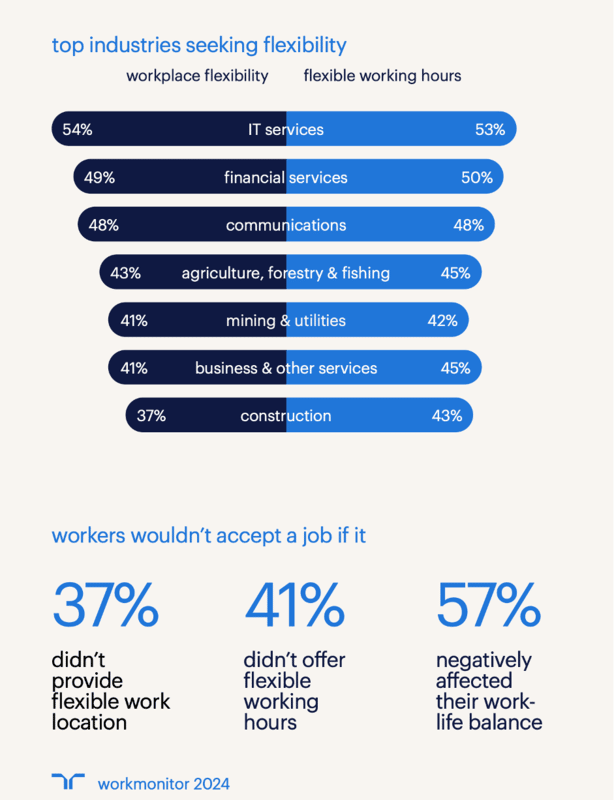
The same report also showed that working from home is non-negotiable for 1 in 3 candidates, and 30% would even quit if they had to spend more time in the office.
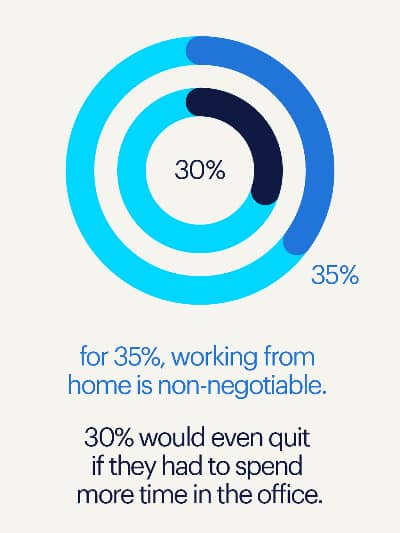
The tech you need to enable flexible work
Using the right tech can help you successfully implement workplace flexibility in your company. Here are some tools and software you might need to enable flex work in your small business.
Customer Relationship Management (CRM) software
CRM software helps you manage customer interactions and sales processes. For flexible work, you need a CRM that keeps everyone on the same page, no matter the employee’s schedule.
Pipedrive, for example, lets you easily set up timelines and assign tasks. CRMs are well-known for sales teams, but Pipedrive is versatile enough to be used across many other teams and purposes, such as marketing, project management and product teams.
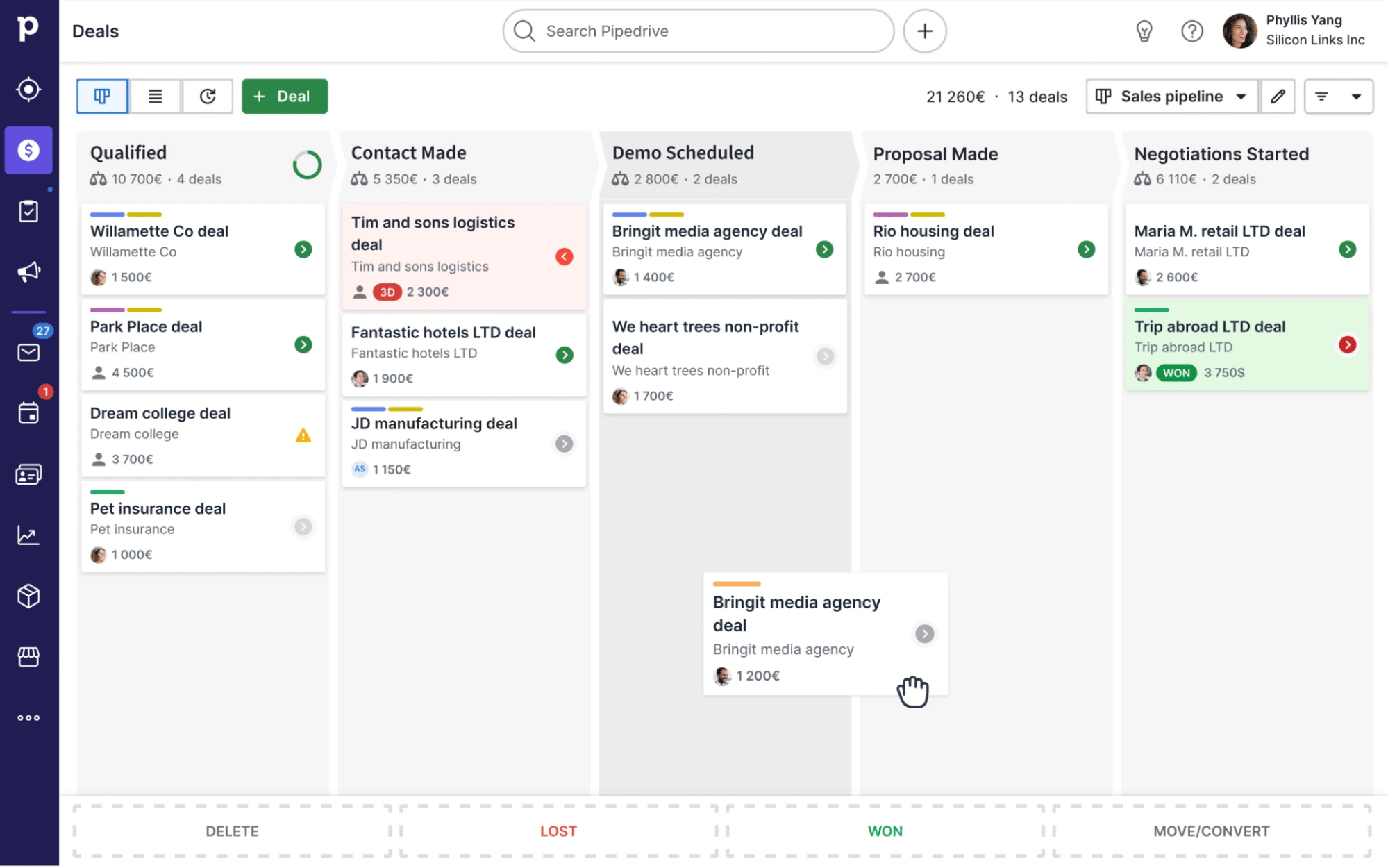
You can also seamlessly manage projects and coordinate with team members across time zones by integrating with third-party tools like Asana, ClickUp and Trello.
Pipedrive makes it easier for your company to implement various flex schedules by setting due dates and times for tasks.
You can block out time with custom fields and labels, or integrate with tools like Outlook and Google Calendar to set core hours.
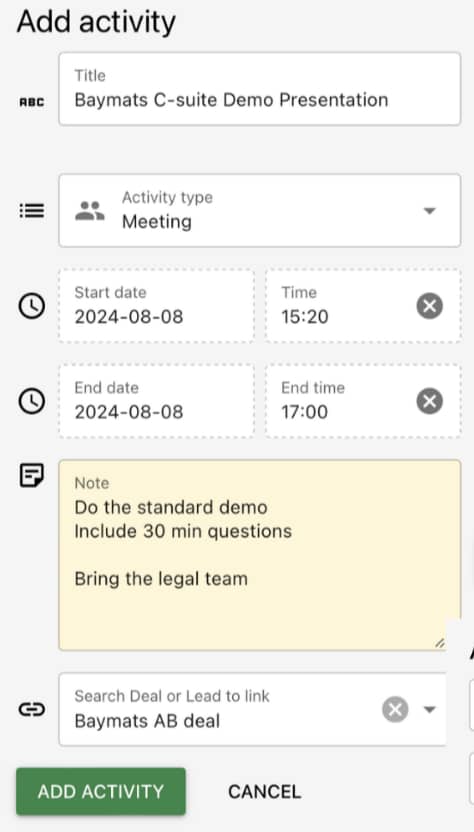
For more complex projects, Pipedrive’s Projects add-on allows you to oversee multiple ongoing projects in a single dashboard. You can define relationships and set tasks to kick off when another finishes.
If your company runs a standard service, you can create project templates for repeated use. Along with those benefits, you can track expenses, budgets and invoices related to each project all in one, handy cloud-based tool.
Download your guide to managing teams and scaling sales
The blueprint you need to find a team of superstars and build a strong foundation for lasting sales success
Cloud-based collaboration tools
Online collaboration tools help flexible teams create, organize, share and edit documents in real time. Google Drive and Airtable, for example, let your employees collaborate on files and databases from anywhere, at any time.
These tools allow you to set up shared project folders or boards and work simultaneously or across different schedules. The setup supports various flex arrangements by facilitating teamwork, productivity and clear communication.
You can also integrate Google Drive with your Pipedrive account. The integration lets you access your Google Drive files directly within Pipedrive so you don’t have to constantly switch between apps.
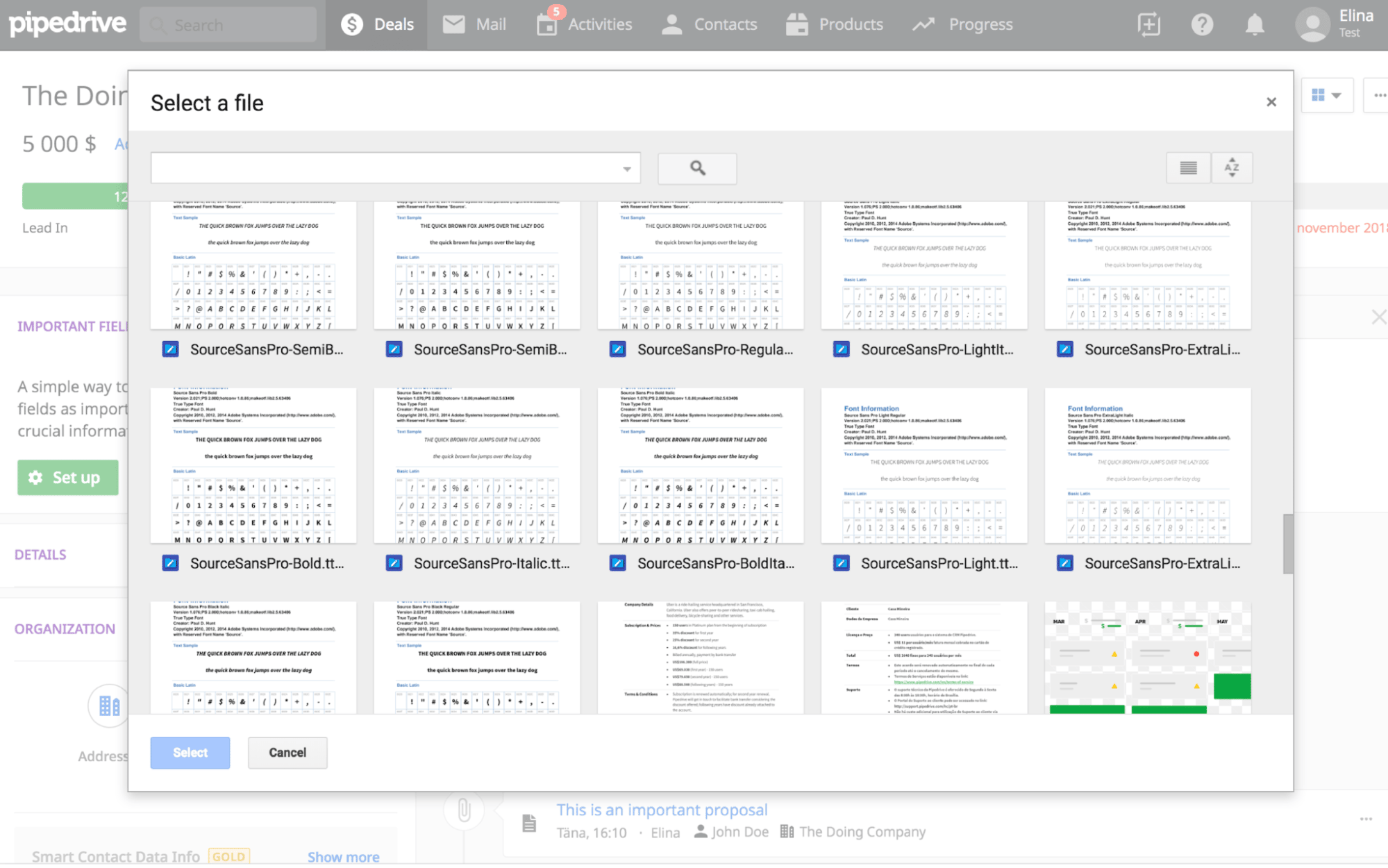
Communication platforms
Communication tools keep your team connected across different schedules and locations. To enable flex work, you’ll need instant messaging and video call platforms.
Slack, for example, is perfect for asynchronous communication. It can organize your conversations into project or team “channels” so employees can receive notifications to stay updated without feeling overwhelmed by real-time meetings.
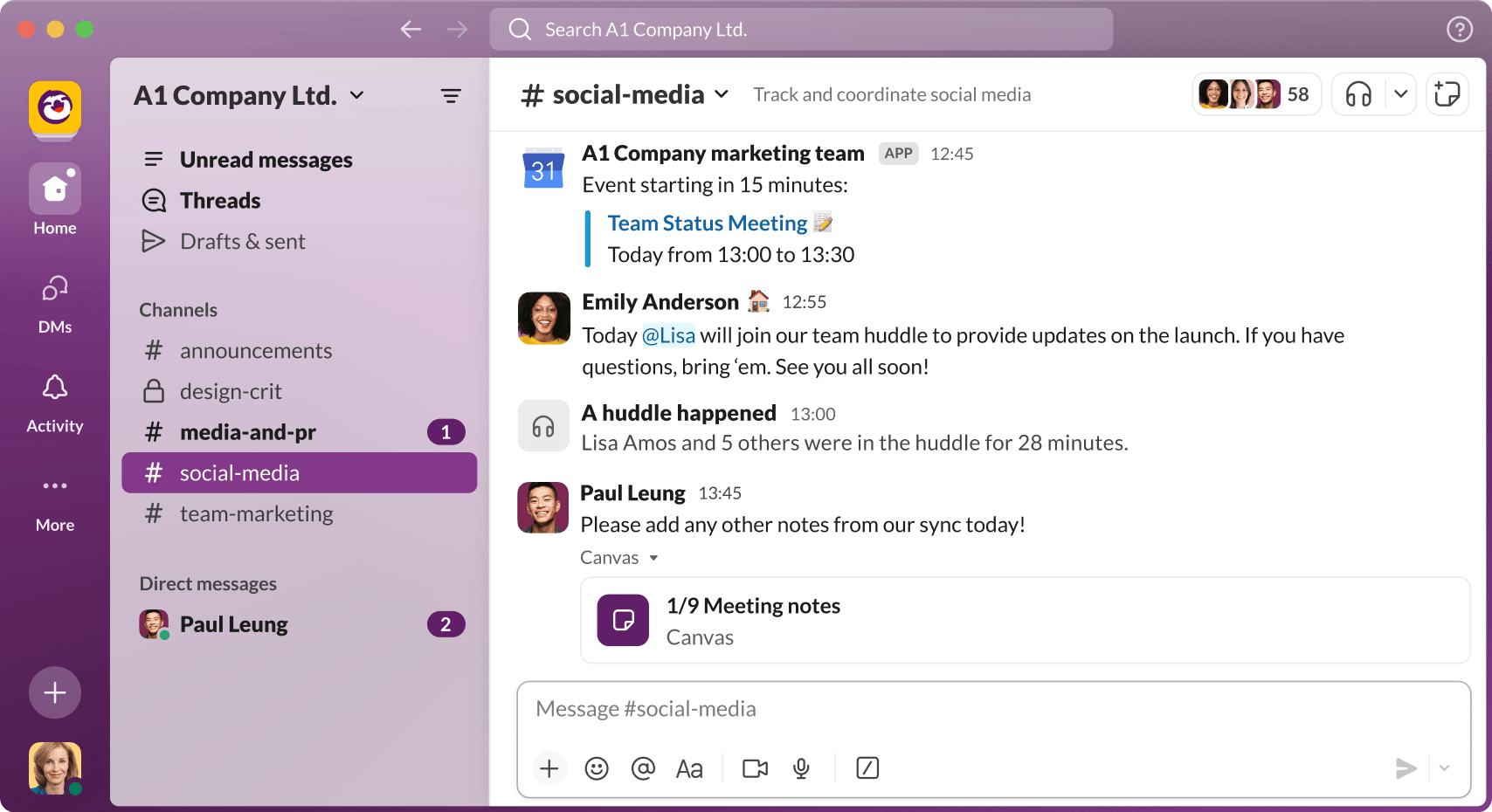
In today’s day and age, no one is a stranger to Zoom. Zoom is a must for any flex working business as it enables face-to-face meetings via video conferencing. The “face time” helps flexible employees maintain personal connections even from a distance.
Time tracking tools
Time tracking tools (e.g., Timely and Taliscape) let you monitor productivity and how much time employees spend on tasks.
Most time tracking tools can generate timesheets, track billable hours and provide reports or dashboards to help your business manage workloads and ensure fair compensation across the organization.
Cybersecurity tools
Cybersecurity tools provide an extra layer of security in flexible work environments, where remote employees may have access to company data.
Below are some types of cybersecurity tools for small and flexible teams:
-
Virtual Private Networks (VPNs) provide secure, encrypted connections for remote access to company networks
-
Encryption tools safeguard sensitive data by converting it into secure, unreadable formats
-
Firewalls monitor and block unauthorized access to company systems
These tools let you confidently implement various flex schedules without compromising security. They protect your customer and business data whether your team works from home, in the office or on a hybrid schedule.
Recommended reading

Enhance login security with two-factor authentication or single sign-on
Flexible work schedule FAQs
Final thoughts
Flexible work schedules can benefit small businesses in many ways. They can help you cut costs, attract better talent and keep employees happier and more productive.
Flex schedules come with challenges, but you can keep processes under control with clear policies, asynchronous communication and the right tools.
Pipedrive’s CRM platform is a must-have for small businesses looking to streamline sales and customer processes, especially in remote and flexible settings. Sign up for a free trial to test the features for yourself. Or learn more about Pipedrive’s project management tools.
If Pipedrive is of interest and you'd like more information, please do make contact or take a look in more detail here.
Credit: Original article published here.
